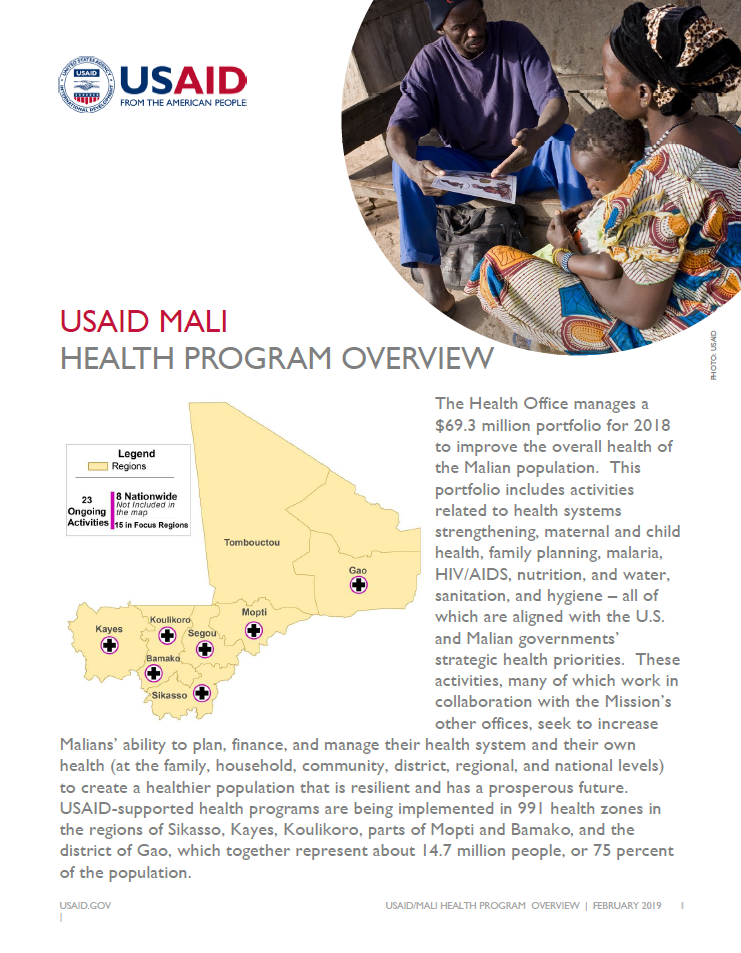Speeches Shim
Health Program Overview ![]() (pdf - 436k)
(pdf - 436k)
The Health Office manages a $69.3 million portfolio for 2018 to improve the overall health of the Malian population. This portfolio includes activities related to health systems strengthening, maternal and child health, family planning, malaria, HIV/AIDS, nutrition, and water, sanitation, and hygiene – all of which are aligned with the U.S. and Malian governments’ strategic health priorities. These activities, many of which work in collaboration with the Mission’s other offices, seek to increase Malians’ ability to plan, finance, and manage their health system and their own health (at the family, household, community, district, regional, and national levels) to create a healthier population that is resilient and has a prosperous future. USAID-supported health programs are being implemented in 991 health zones in the regions of Sikasso, Kayes, Koulikoro, parts of Mopti and Bamako, and the district of Gao, which together represent about 14.7 million people, or 75 percent of the population.
PREVENTING MATERNAL AND CHILD DEATHS
In line with USAID’s global health priorities, the overall goals of USAID Mali’s health program are to prevent child and maternal deaths and to combat infectious disease threats through increased use of high-impact health services and adoption of healthy behaviors. To prevent maternal and child deaths, USAID implements activities to increase the availability and utilization of quality antenatal care and obstetric care services, newborn health services, and child health services. This includes training providers in antenatal care and increasing the number of women who attend antenatal services; ensuring skilled attendance at birth and training providers in basic and emergency obstetric care; training providers in essential newborn care; ensuring care for low-birthweight babies; treating neonatal infections; treating childhood illnesses including diarrhea, pneumonia, and malaria; and improving the routine immunization system. Since malnutrition is an underlying cause of up to 45 percent of deaths in children under the age of five, USAID also supports activities to improve infant and young child feeding; increases the local production of nutrient-rich foods; trains community health workers in the management of acute malnutrition; and conducts micronutrient supplementation campaigns to distribute vitamin A to young children and iron and folic acid to pregnant women. To complement all of these activities, the adoption of healthy behaviors is promoted through social and behavior change messaging through interpersonal communication and local media such as community radio.
COMBATING INFECTIOUS DISEASES
To combat malaria, the leading cause of child mortality in Mali, USAID procures essential commodities including insecticide-treated bednets, rapid diagnostic tests for malaria, and malaria treatment medications. USAID supports seasonal malaria chemoprophylaxis, a program that gives preventative malaria treatments to children under the age of five during the high-transmission season for malaria, and supports indoor residual spraying against mosquitos in certain high-transmission areas. USAID also supports the training and supervision of health workers in the diagnosis and treatment of malaria. To combat HIV/AIDS, USAID activities support HIV prevention, testing, and linkages to treatment among certain key populations who have a much higher prevalence of HIV than the general population.
JOURNEY TO SELF-RELIANCE
To enable Malians to be able to better plan, finance, and manage their own health and health systems at all levels, USAID supports many health systems strengthening and community capacity-building activities. Key health systems must function well at all levels of the health care pyramid to effectively ensure the delivery of quality health services. For example, family planning services cannot be offered at the community level if the national contraceptive commodity logistics system does not function smoothly. Family planning commodities must be accurately quantified, ordered in a timely manner, and distributed from the national to the community level to ensure a steady supply of products at service delivery points. Other key health systems include the health management information systems; governance and accountability; human resources; and health financing. To increase self-reliance at the community level, USAID also supports interventions designed to enable communities to hold health workers and local governance officials accountable for the availability and quality of health services; increase engagement with and ownership of local health services; and to reduce local cultural barriers to the adoption of healthy behaviors.


Comment
Make a general inquiry or suggest an improvement.